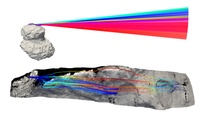COBS News archive
New Comet C/2021 E3 (ZTF)
May 07, 2021
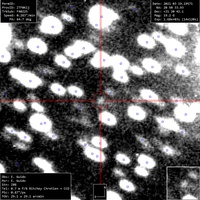
CBET xxxx & MPEC 2021-J71 , issued on 2021, May 06, announce the discovery of an apparently asteroidal object (magnitude ~19.5) on CCD images taken on March 09.5 UT with the 1.2-m Schmidt telescope at Palomar in the course of the "Zwicky Transient Facility" (ZTF) search program. This object has been found to show cometary appearance by CCD astrometrists elsewhere. The new comet has been designated C/2021 E3 (ZTF).
Exploring comet thermal history: Burnt-out comet covered with talcum powder
April 09, 2021
The world's first ground-based observations of the bare nucleus of a comet nearing the end of its active life revealed that the nucleus has a diameter of 800 meters and is covered with large grains of phyllosilicate; on Earth large grains of phyllosilicate are commonly available as talcum powder. This discovery provides clues to piece together the history of how this comet evolved into its current burnt-out state.
New Comet C/2019 U5 (PANSTARRS)
April 09, 2021
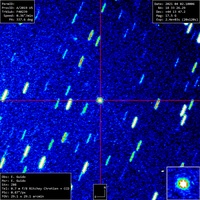
CBET 4953 & MPEC 2021-G80, issued on 2021, April 07, announce that an apparently asteroidal object (magnitude ~21.0) discovered on CCD images obtained with the F51 Pan-STARRS 1 survey's 1.8m Ritchey-Chretien on 2019, October 22.22 and designated A/2019 U5 (cf. MPEC 2019-V10) has been found to show cometary appearance by other CCD observers over the past half year. The new comet has been designated C/2019 U5 (PANSTARRS).
First interstellar comet may be the most pristine ever found
April 01, 2021
New observations indicate that the rogue comet 2I/Borisov, which is only the second and most recently detected interstellar visitor to our Solar System, is one of the most pristine ever observed. Astronomers suspect that the comet most likely never passed close to a star, making it an undisturbed relic of the cloud of gas and dust it formed from.
New Comet C/2020 F7 (Lemmon)
March 27, 2021
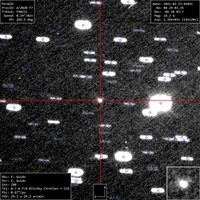
CBET 4949 & MPEC 2021-F110, issued on 2021, March 25, announce that an apparently asteroidal object (magnitude ~21.0) discovered on CCD images obtained with the Mt. Lemmon Survey's 1.5-m reflector on 2020 Mar. 22 and designated A/2020 F7 (cf. MPEC 2020-G78) has been found to show cometary appearance by numerous other CCD observers over the past half year. The new comet has been designated C/2020 F7 (Lemmon).
FLI Camera type keys
March 26, 2021
New Comet C/2021 D2 (ZTF)
March 23, 2021
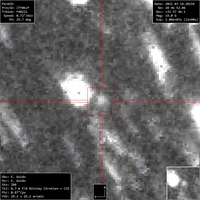
CBET 4948 & MPEC 2021-F67, issued on 2021, March 22, announce the discovery of an apparently asteroidal object (magnitude ~19.5) on CCD images taken on Feb. 19.5 UT & Mar. 09-5 with the 1.2-m Schmidt telescope at Palomar in the course of the "Zwicky Transient Facility" (ZTF) search program (the object was reported twice by the ZTF survey team as two different objects) . This object has been found to show cometary appearance by CCD astrometrists elsewhere. The new comet has been designated C/2021 D2 (ZTF).
Comet Catalina suggests comets delivered carbon to rocky planets
March 07, 2021
New Comet C/2021 C4 (ATLAS)
March 02, 2021
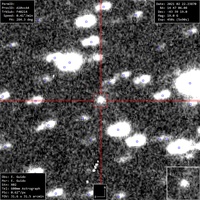
CBET 4937 & MPEC 2021-D113, issued on 2021, February 26, announce the discovery of an apparently asteroidal object (magnitude ~19) on CCD images taken on Feb. 12.6 UT with a 0.5-m f/2 Schmidt reflector at Haleakala, Hawaii, in the course of the "Asteroid Terrestrial-Impact Last Alert System" (ATLAS) search program. This object has been found to show cometary appearance by CCD astrometrists elsewhere after the object was posted on the Minor Planet Center's PCCP webpage due to its orbit. The new comet has been designated C/2021 C4 (ATLAS).
Comet makes a pit stop near Jupiter's asteroids
February 26, 2021
After traveling several billion miles toward the Sun, a wayward young comet-like object orbiting among the giant planets has found a temporary parking place along the way. The object has settled near a family of captured ancient asteroids, called Trojans, that are orbiting the Sun alongside Jupiter. This is the first time a comet-like object has been spotted near the Trojan population.
The comet that killed the dinosaurs
February 15, 2021
New Comet C/2021 B3 (NEOWISE)
February 06, 2021
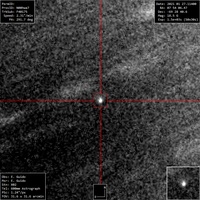
CBET 4929 & MPEC 2021-C16, issued on 2021, February 04, announce the discovery of a comet (magnitude ~19) in infrared images obtained during Jan. 22 UT with the Near-Earth Object Wide-field Infrared Survey Explorer (or NEOWISE; formerly the WISE earth-orbiting satellite). The new comet has been designated C/2021 B3 (NEOWISE).
New Comet C/2021 A1 (Leonard)
January 31, 2021
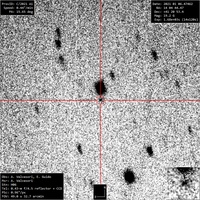
Recently discovered comet seen during 2020 total solar eclipse
December 20, 2020
Comet Discovered to Have Its Own Northern Lights 2020-12-10
December 10, 2020
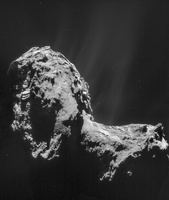
Philae’s second touchdown site discovered at ‘skull-top’ ridge
October 29, 2020
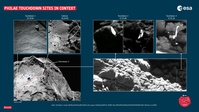
After years of detective work, the second touchdown site of Rosetta’s Philae lander has been located on Comet 67P/Churyumov-Gerasimenko in a site that resembles the shape of a skull. Philae left its imprint in billions-of-years-old ice, revealing that the comet’s icy interior is softer than cappuccino froth.
QHYCCD Camera type keys
September 22, 2020
Comet discovered to have its own northern lights 2020-09-21
September 21, 2020
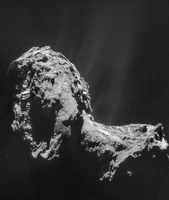
New Comet C/2020 S3 (Erasmus)
September 21, 2020
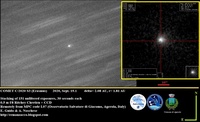
CBET 4885 & MPEC 2020-S119, issued on 2020, September 20, announce the discovery of a comet (magnitude ~18.5) by Nicolas Erasmus (South African Astronomical Observatory), in four 30-s CCD images taken in 5" seeing on Sept. 17.6 UT with a 0.5-m f/2 Schmidt reflector at Mauna Loa, Hawaii, in the course of the "Asteroid Terrestrial-Impact Last Alert System" (ATLAS) search program. The new comet has been designated C/2020 S3 (Erasmus).
Rainbow comet with a heart of sponge
September 07, 2020
